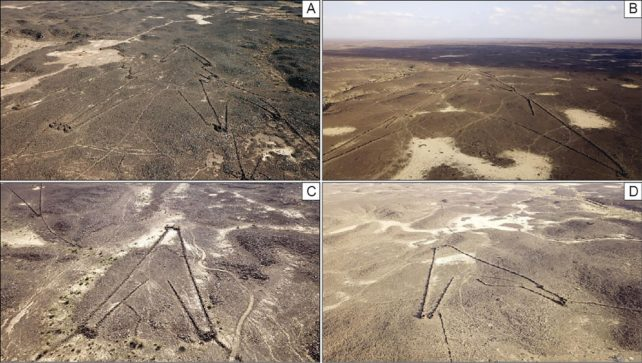The deserts of Saudi Arabia were once home to ancient civilizations more than 8,000 years ago. Today, the remains of these communities can still be found, and preserved in the desert climate. Across the Arabian peninsula, from Jordan to Saudi Arabia to Syria, Armenia, Kazakhstan, and Iraq, researchers have used aerial photography to identify thousands of large stone structures.
These structures offer a glimpse into the past and provide valuable information about the lives of these ancient people. Despite the harsh desert conditions, these structures have stood the test of time and continue to fascinate researchers and history enthusiasts alike.
Researchers have found thousands of large stone structures across the Arabian peninsula, from Jordan to Saudi Arabia to Syria, Armenia, Kazakhstan, and Iraq. The V-shaped formations were first spotted by British air force pilots in the 1920s, and experts have been unsure of their purpose for over 100 years. Recent satellite images and drone surveys support the theory that the structures, known as "desert kites," were likely used for mass hunting.
Mass Hunting Traps
Recently, dozens of new desert kites were discovered in ʿUwayriḍ, and they all appear to have been built for the same purpose. Some of the V-shaped structures point toward pits, cliffs, or enclosures, which suggests that they were used to direct herds of animals toward their death or capture. These findings support the theory that desert kites were used as mass hunting traps.
The purpose of desert kites is generally agreed upon by researchers: they were used to drive or guide animals into a restricted area by the structure's walls. Hunting of gazelle and other herbivorous ungulates is the most commonly accepted use of these structures, though ibex, wild equids, and ostriches may have also been targeted. Further excavations are needed to determine which animals were specifically herded into the recently discovered traps, but the fact that similar structures have been found in other parts of the Arabian peninsula suggests that this was a popular and effective hunting strategy.
Furthermore, in the southern regions of the Arabian peninsula, archaeologists have discovered hundreds of stone kites and thousands of other stone structures in the desert. These structures tend to be more complex and concentrated than those in the ʿUwayriḍ desert, and some of them combine multiple V-shaped structures. These findings suggest that the use of desert kites as hunting traps was widespread throughout the region.

Arabian 'Desert Kites'
In the past, archaeologists have suggested that desert kites were used as hunting traps because they are often found in areas that would have once had seasonal grasslands, which would have supported migrating gazelle, goats, and other herding animals. Additionally, some ancient rock art images from this period show kite-like structures being used to funnel animals. The layout of some of these structures even suggests that they may have been used to raise wild animals, making them some of the earliest known attempts at domestication.
A recent study on desert kites published in April 2022 found that it is common for a single region to have a mix of kites with different functions. Some of these kites open up to pits at the end, while others open up to enclosures. The researchers suggest that this may indicate that different hunting techniques were used in the same area, or that one technique may have led to the development of the other over time. They also propose the existence of "proto-kites" that predate the more sophisticated and standardized forms of desert kites.
Further research is needed to determine the exact purpose of desert kites and their relationship to mustatils. The study of these structures could provide insight into how early humans first began hunting and domesticating animals. It is possible that getting close to wild herds allowed our species to breed and raise them as our own. However, not all aspects of these structures are necessarily functional.
Some kites have been found embedded in even larger stone structures called mustatils, which can extend for kilometers. The function of mustatils is unclear, but they may have been used for spiritual or cultural purposes, such as animal sacrifices or feasts. Their association with desert kites suggests that they could also have been used for corralling animals or storing water.
Stone Structures May be Related to Desert Kites
The fact that these stone structures can be found throughout the region and were in use for thousands of years suggests that they were either highly effective or highly valued by the people who built them. However, little is known about the people who used these structures. Further dating and excavation of related sites are needed to better understand their association with a particular cultural group. Despite being known for decades, desert kites in Saudi Arabia have received relatively little attention from the scientific community.
For years, archaeologists have been calling for more research on the remains of ancient communities in the Arabian peninsula. In early 2022, archaeologists working in Saudi Arabia discovered a 530-kilometer-wide network of lost highways in the country's northwest. These ancient roads were lined with thousands of spiraling, stone burial chambers that connected one oasis to another. Many of these oases also contained desert kites. These findings suggest that there is still much to learn about the ancient cultures that inhabited the region.
The archaeologists who discovered the lost highways in Saudi Arabia believe that they were used by ancient nomadic peoples who were seeking out the best lands and climates. Thousands of years later, archaeologists are trying to retrace their steps and learn more about these ancient cultures. The research on desert kites has been published in the Journal of Archaeological Science: Reports, while the research paper on the unknown desert kites was published in Arabian Archaeology and Epigraphy.
Check out more news and information on the Anthropology and Archaeology Science Times.
© 2025 ScienceTimes.com All rights reserved. Do not reproduce without permission. The window to the world of Science Times.










